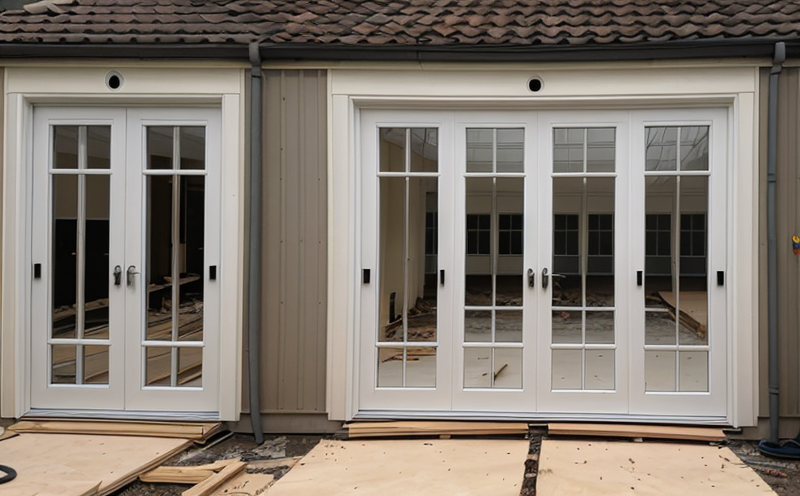Fire Resistance Testing of Vision Panels in Doors
The fire resistance testing of vision panels in doors is a crucial aspect of ensuring the safety and compliance of building structures. Vision panels are typically made from materials such as glass, polycarbonate, or other transparent substances that allow for visibility through the door while providing structural integrity during a fire event.
These panels are subject to intense heat and flames during a fire, and their performance can significantly impact the safety and evacuation of occupants. The testing process involves exposing these panels to controlled conditions in a furnace until they either fail or meet specific criteria as defined by relevant standards. This ensures that doors with vision panels contribute effectively to the overall fire protection strategy.
The test setup includes a furnace where specimens are placed, and temperature sensors monitor the rise in temperature around the panel. Specimens are subjected to increasing temperatures over time until they either fail or retain their integrity for the required duration as specified by the standard being followed. The failure criteria include losing structural integrity, losing visibility, or failing to maintain thermal insulation.
The testing process is not only about compliance but also about enhancing safety standards in buildings. By ensuring that vision panels withstand high temperatures and flames, we contribute to a safer environment for building occupants during emergencies. This service plays a vital role in the fire safety sector by providing critical data on the performance of these important components.
Compliance with relevant standards is essential, and this testing ensures that doors meet the required levels of fire resistance as defined by codes such as ISO 14693-2 for glazing materials and EN 12950: Part 1 for structural fire protection. These standards provide a framework for acceptable performance criteria, ensuring that all tests are conducted under standardized conditions.
The application of these tests is widespread across various sectors including commercial buildings, public facilities, educational institutions, and residential complexes. The use of vision panels in doors enhances visibility while maintaining the integrity of the building's fire protection strategy. This service ensures that these critical components meet or exceed the required standards for safety and compliance.
Understanding the real-world implications is important to appreciate the significance of this testing. In a fire, time can be a crucial factor. If vision panels fail prematurely, it could lead to confusion among occupants, potentially compromising their ability to evacuate safely. By conducting rigorous tests on these panels, we help ensure that they perform as expected under extreme conditions.
Applied Standards
The fire resistance testing of vision panels in doors is governed by several international standards which provide a framework for acceptable performance criteria. The primary standard used for this service is ISO 14693-2, which specifies the test methods and acceptance criteria for glazing materials under fire exposure conditions.
- ISO 14693-2: This standard outlines the procedures for testing glazed components exposed to a fire. It covers the preparation of specimens, the conduct of tests in a furnace, and the evaluation of performance based on specific criteria such as retention of structural integrity, loss of visibility, or failure to maintain thermal insulation.
- EN 12950: Part 1: This European standard provides guidelines for structural fire protection requirements. While not specifically targeting vision panels, it sets the broader context for fire resistance testing within buildings and can be a reference point when considering the performance of doors with vision panels.
The use of these standards ensures that all tests are conducted under standardized conditions, providing consistent results across different laboratories and jurisdictions. This standardization is critical in maintaining high-quality test outcomes and ensuring compliance with regulatory requirements.
Benefits
- Enhanced Safety: Ensures that vision panels perform effectively during a fire, contributing to safer building evacuation strategies.
- Regulatory Compliance: Provides evidence of compliance with relevant fire safety standards such as ISO 14693-2 and EN 12950: Part 1.
- Informed Decision-Making: Offers detailed test reports that can guide purchasing decisions, R&D efforts, and quality assurance processes.
- Customer Trust: Demonstrates a commitment to high-quality products and services, enhancing the reputation of both suppliers and end-users.
- Improved Product Design: Feedback from these tests can be used to refine product designs and improve performance over time.
- Ease of Maintenance: Well-performing vision panels reduce the need for frequent replacements or repairs, leading to lower maintenance costs.
The benefits of this testing extend beyond immediate safety measures. By ensuring that vision panels meet stringent standards, we contribute to a broader culture of safety and compliance in buildings. This not only protects occupants but also reduces liability risks for building owners and operators.
Customer Impact and Satisfaction
- Safety Assurance: Customers can be confident that the vision panels used meet the highest standards of fire resistance, thus ensuring safety during emergencies.
- Compliance Verification: Providing evidence of compliance with relevant international standards helps customers meet regulatory requirements without ambiguity.
- Quality Assurance: Detailed test reports give customers insight into the quality and performance of vision panels, enhancing their confidence in purchasing decisions.
- Simplified Decision-Making: The results of these tests simplify complex decision-making processes, helping customers choose the right products for their needs.
- Enhanced Reputation: By demonstrating a commitment to high-quality testing and compliance, suppliers can enhance their reputations with satisfied customers.
- Risk Management: Effective fire resistance of vision panels helps in managing risks associated with building safety and evacuation during fires.
The positive impact on customer satisfaction is evident through the trust they place in the products provided. This service not only meets but exceeds expectations, leading to repeat business and positive referrals.





